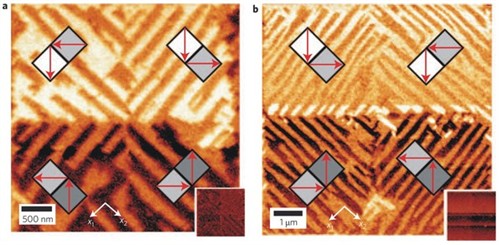Home > Press > Researchers can precisely manipulate polarization in nanostructures
 |
| Manipulation of the polarization in nanostructures. In Figure a, the researchers created an artificial star; in Figure b there is a diamond pattern. |
Abstract:
Data storage with very high data densities on the horizon
Researchers can precisely manipulate polarization in nanostructures
The Netherlands | Posted on October 26th, 2009Researchers from the MESA+ Institute for Nanotechnology at the University of Twente, working with American researchers, have succeeded in using an electrical signal to control both the elastic and the magnetic properties of a nanomaterial at a very localized level. This opens up new possibilities for data storage with very high data densities. Their findings are to be published in November in the leading scientific journal Nature Nanotechnology.
In what are known as 'multiferroic' materials, the electrical, magnetic and elastic properties of the material are coupled. These materials make it possible to create new, complex structures that are suitable for e.g. data storage. Until recently, nobody had succeeded in controlling these multiferroic properties, but researchers from Oakridge National Laboratory (USA), the University of California, Berkeley (USA), Pennsylvania State University (USA) and the University of Twente's MESA+ Institute for Nanotechnology demonstrate in the next issue of Nature Nanotechnology that it is indeed possible.
In their experiments, the scientists succeeded in manipulating a nanostructure made of bismuth ferrate (BiFeO3) in an ordered way using scanning probe microscopy. This is a technique in which a surface can be manipulated at the atomic scale, using a miniscule needle.
By applying an electrical voltage to the needle and moving it over the surface of the material, the scientists are able to 'charge' a nanomaterial with different elastic and magnetic properties at a very localized level. This opens new avenues for data storage with very high information densities.
Notes for the press
The article 'Deterministic control of ferroelastic switching in multiferroic materials' by N. Balke, S. Jesse, A. P. Baddorf, S. V. Kalinin (ORNL), Y. H. Chu, R. Ramesh (UC Berkeley), S. Choudhury and L. Q. Chen (Penn State) and M. Huijben (MESA+) will appear in the November issue of Nature Nanotechnology. We can send you the publication as a PDF file by e-mail.
####
About University of Twente
The University of Twente is an entrepreneurial research university. It is the only campus University in the Netherlands and provides academic education and research in a wide variety of fields, for example from psychology to public administration and applied physics to biomedical technology. The University of Twente is part of the 3TU.Federation and works cooperatively with Delft University of Technology and Eindhoven University of Technology. The University of Twente is also a member of the European Consortium of Innovative Universities.
For more information, please click here
Contacts:
Joost Bruysters
+31 (0)53‑489‑2773
Copyright © University of Twente
If you have a comment, please Contact us.Issuers of news releases, not 7th Wave, Inc. or Nanotechnology Now, are solely responsible for the accuracy of the content.
| Related News Press |
News and information
![]() Researchers develop molecular qubits that communicate at telecom frequencies October 3rd, 2025
Researchers develop molecular qubits that communicate at telecom frequencies October 3rd, 2025
![]() Next-generation quantum communication October 3rd, 2025
Next-generation quantum communication October 3rd, 2025
![]() "Nanoreactor" cage uses visible light for catalytic and ultra-selective cross-cycloadditions October 3rd, 2025
"Nanoreactor" cage uses visible light for catalytic and ultra-selective cross-cycloadditions October 3rd, 2025
Possible Futures
![]() Spinel-type sulfide semiconductors to operate the next-generation LEDs and solar cells For solar-cell absorbers and green-LED source October 3rd, 2025
Spinel-type sulfide semiconductors to operate the next-generation LEDs and solar cells For solar-cell absorbers and green-LED source October 3rd, 2025
Memory Technology
![]() Researchers tackle the memory bottleneck stalling quantum computing October 3rd, 2025
Researchers tackle the memory bottleneck stalling quantum computing October 3rd, 2025
![]() First real-time observation of two-dimensional melting process: Researchers at Mainz University unveil new insights into magnetic vortex structures August 8th, 2025
First real-time observation of two-dimensional melting process: Researchers at Mainz University unveil new insights into magnetic vortex structures August 8th, 2025
![]() Utilizing palladium for addressing contact issues of buried oxide thin film transistors April 5th, 2024
Utilizing palladium for addressing contact issues of buried oxide thin film transistors April 5th, 2024
Announcements
![]() Rice membrane extracts lithium from brines with greater speed, less waste October 3rd, 2025
Rice membrane extracts lithium from brines with greater speed, less waste October 3rd, 2025
![]() Researchers develop molecular qubits that communicate at telecom frequencies October 3rd, 2025
Researchers develop molecular qubits that communicate at telecom frequencies October 3rd, 2025
![]() Next-generation quantum communication October 3rd, 2025
Next-generation quantum communication October 3rd, 2025
![]() "Nanoreactor" cage uses visible light for catalytic and ultra-selective cross-cycloadditions October 3rd, 2025
"Nanoreactor" cage uses visible light for catalytic and ultra-selective cross-cycloadditions October 3rd, 2025
|
|
||
|
|
||
| The latest news from around the world, FREE | ||
|
|
||
|
|
||
| Premium Products | ||
|
|
||
|
Only the news you want to read!
Learn More |
||
|
|
||
|
Full-service, expert consulting
Learn More |
||
|
|
||








